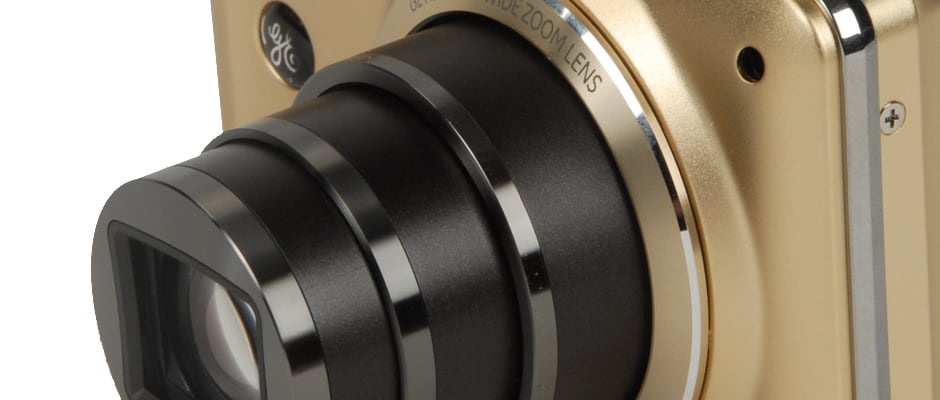Introduction
The list of features is nice, and we can certainly appreciate an MSRP of $159.99, but as far as actual performance, we will know the true stats once we have run it through our gauntlet of testing back at the labs. The {{product.model}} will ship this January in black, red, brown, and champagne.
Design & Appearance
{{section_header}}{{section.name}}{{/section_header}}
At .7-inches thick, this high-functioning point-and-shoot is slim for what it offers. The "travel anywhere" description matches the body of this model as it would be easy to pop in just about any pocket. Other than the diminutive overall size, the {{product.model}} isn't breaking new ground in the field of camera design: it's the standard rounded edge rectangle. The color variations are not overly bright, done in black, red, brown, and champagne.
Tour
{{section_header}}{{section.name}}{{/section_header}}




Menu
{{section_header}}{{section.name}}{{/section_header}}
There is a menu for modes and one for the other functions of the camera. The interface is simple. There are not too many complicated options to make the menu system very confusing, which will be great for the beginner or intermediate user. The response time of moving through the various settings was slow. The buttons being a bit stiff, and the menus a little slow made it hard to tell if you had pushed a button or if the menu had just not responded yet. Overall, the user interface is well labeled and clearly manageable.
Ease of Use
{{section_header}}{{section.name}}{{/section_header}}
There are only a few buttons on this little guy. On the top are the shutter release, the power button and a quick movie mode button. On the back, from top to bottom are the Mode, Directional Pad, Set, Function Menu, and Playback buttons.
The directional pad not only gets you around the playback of photos and options in the menu, it also has it's own functionality, with each direction serving a purpose. When not in any menu, the right button quickly gets you to the flash settings, the left switches between macro modes, the up button displays more information and the down button toggles the burst shooting modes.
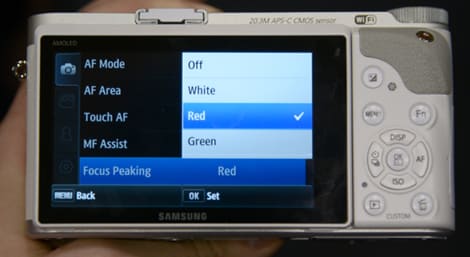

Size & Handling
{{section_header}}{{section.name}}{{/section_header}}
This camera is great for traveling, weighing in at 135g, not even an inch thick and 3.9 inches in width.
You an easily hold it in one hand, and though there is not much in the way of contouring, there is a thumb grip above the Mode button making it easy to hold without gripping it awkwardly.
From a resting position, all buttons are all well within reach. The intuitive layout will provide quick access to most of the functions on the camera. We noticed that each button was a little stiff though. It could take a few pushes to get something to pop up. The shutter button especially did not have the best tactile response. Pushing halfway down engages the autofocus, and all the way takes a picture. Distinguishing between the two was difficult, often we would take a picture when trying to focus, or vice versa.
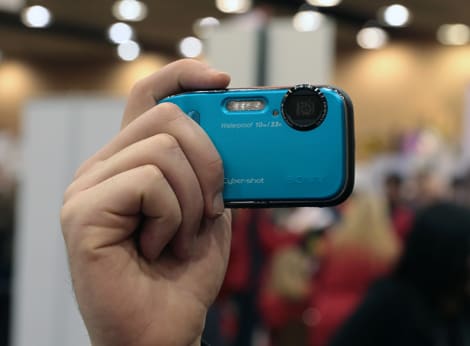
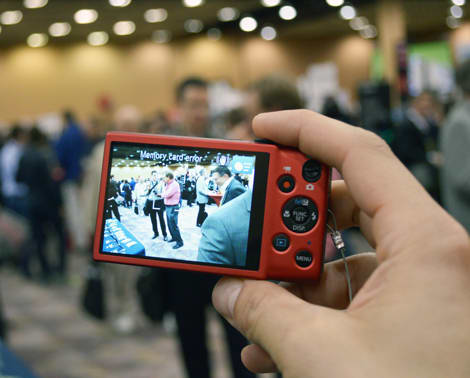
Modes Overview
{{section_header}}{{section.name}}{{/section_header}}
This GE camera is not for the advanced photographer, so you won't see the regular PASM modes. Instead, you get Auto, Manual, Movie, Panoramic, Scene, and Face Beautifier modes. These modes are easy to change between by hitting the mode button on the back of the {{product.model}}.

Auto Mode
{{section_header}}{{section.name}}{{/section_header}}
Most of your photos will be taken in Auto mode with this point-and-shoot. This setting is easy to use and takes solid photos.
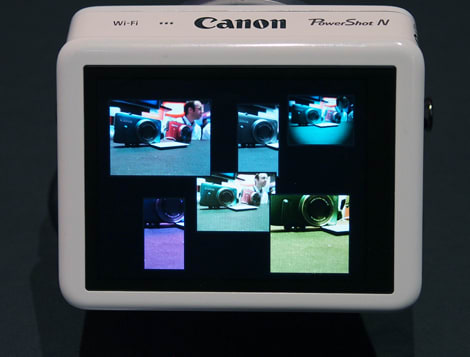
Movie Mode
{{section_header}}{{section.name}}{{/section_header}}
You can shoot video at 1080p in 30fps, 720p in both 60 and 30fps, VGA, and QVGA. You can use the optical zoom in movie mode, but do not expect too many other video extras. This option is mostly intended for quick video capture.
Drive/Burst Mode
{{section_header}}{{section.name}}{{/section_header}}
The {{product.model}} is capable of continuous shooting 10 pictures per second at full resolution. As well, there were options for self-timing photos that lived in the same menu as the smile detection function that will not take the photo until all subjects showing an appropriate amount of happiness on their faces.
Playback Mode
{{section_header}}{{section.name}}{{/section_header}}
Photo playback is accessible by the play button on the back. Scrolling through photos can take some time though, the menus can be slow and without a scroll wheel, you need to use the directional pad, which has a very stiff tactile feedback.
If you hit the display button in playback, you can get some information as to when the photo was taken and a mini histogram showing the light levels. Using the zoom toggle on the top, you can zoom in a couple of times on your photos.
Picture Quality & Size Options
{{section_header}}{{section.name}}{{/section_header}}
You can shoot photos in 4:3, 3:2, and 16:9 formats in varying resolutions, as well as in Fine or Normal modes. Video can be recorded at 1080p 30fps, 720p 30 or 60fps, VGA, and QVGA resolutions.
Photos can be recorded with three types of compression: Normal, Fine, and Best.
Other Modes
{{section_header}}{{section.name}}{{/section_header}}
Using the mode selection screen, you can choose to shoot a linked panoramic shot, a function that works rather well. There is a target that connects the first shot to the next, and the third shot to the second, the result is a high definition, wide, panoramic shot of wherever you happen to be.
Also in the mode selection screen is the option for Face Beautifier, which is GE's optimization for portrait photos. This setting softens skin tones, brightens and enlarges the eyes. It was hard to tell how well this function worked at the GE presentation, but we should have a full report on it some time this year.
Focus
{{section_header}}{{section.name}}{{/section_header}}
There are three autofocus modes, Single Point, Multi-point, and Object Tracking autofocus. Another menu option allows you to turn contrast autofocus on or off, which affects the previous settings listed here.
When taking pictures, the autofocus was not great. It seemed to take a moment before the processor spoke to the lens and actually focused. Also, pushing the shutter button down halfway was not easily repeatable. It was hard to tell where halfway was, and often we ended up taking a photo instead of focusing.
Exposure & Metering
{{section_header}}{{section.name}}{{/section_header}}
For exposures, you can choose a manual mode where you choose your own settings, but on this point-and-shoot, shutter priority or aperture priority are not available modes. There are three metering modes on the {{product.model}}: Spot, Multi, and AiAE (Artificial Intelligence Auto Exposure), which first figures out the setting and subjects in the photos and then determines the proper exposure metering to use. AiAE is the default metering mode on this GE.
You get a narrow range of F-stops on this camera from f/3.2 to f/5.6. For exposure compensation, you can go +/- 3 in 1/3 step increments.
ISO
{{section_header}}{{section.name}}{{/section_header}}
ISO can be set to auto, or manually adjusted from ISO 100 up to ISO 3200.
White Balance
{{section_header}}{{section.name}}{{/section_header}}
White balance options are right in the main menu, but it is not necessarily labeled intuitively. The camera defaults to Auto White Balance, which is nice for the beginner. But, the picture of Auto becomes the picture header for the white balance menu, and it looks like an A with some triangles below it, which can be confusing.
Within the menu are pictures are various types of light sources and each will change the white balance for the following settings: daylight, cloudy, fluorescent, fluorescent CWF, incandescent, and manual. We were not surprised by a lack of a kelvin control in this menu as this is a beginner's camera.
Image Stabilization
{{section_header}}{{section.name}}{{/section_header}}
The {{product.model}} uses an optical image stabilization to keep shaky hands from ruining a perfectly good shot. We took a few pictures, zoomed all the way in, with the stabilization on and off, and noticed that the stabilized pictures were definitely a little bit sharper.
From this anecdotal evidence it is hard to say for certain how well the mode works, but subjectively we noticed this setting performing its job stoically.
Picture Effects
{{section_header}}{{section.name}}{{/section_header}}
The list of scene modes is extensive. If you set the camera to Scene, you can use the preset optimizations for Portrait, Sport, Landscape, Children, Indoor, Leaf(?...probably this is for foliage), Snow, Sunset, Fireworks, Glass, Museum, Night Landscape, Night Portrait, Beach, Text, Party, ID, Pet (both Cat and Dog, none for small or exotic animals). As well, there are a couple of filters and settings that will edit your photos, like Photo Frame and Sketch.
Lens & Sensor
{{section_header}}{{section.name}}{{/section_header}}
The 14.41-megapixel Aptina lens uses CMOS technology and can zoom up to 10x. The sensor is a 1/2.3-inch, which is actually quite good for a point-and-shoot, but not into the realm of spectacular.

LCD
{{section_header}}{{section.name}}{{/section_header}}
No viewfinder here, you will have to use the built-in, 3-inch, 230,400 pixel LCD display. It is not the most high-def display we have seen on a camera of this type, but it is certainly functional for taking photos.

Flash
{{section_header}}{{section.name}}{{/section_header}}
The flash bulb is set into the front of the camera. At ISO 100, the guide number for the flash is 5.9 meters. The flash default is automatic but there are a number of modes like Red-eye Reduction, Forced Flash, No Flash, Slow Synchro, Red Eye and Slow Synchro.

Jacks, Ports & Plugs
{{section_header}}{{section.name}}{{/section_header}}
There is a connection for USB 2.0 and a mini-HDMI to HDMI port too. The USB port is ready to use with the included USB cable, but you will have to pick up an HDMI cable for that piece of functionality. The port cover is right on the left side. By plucking out a little rubber stopper, the ports are easily accessible.
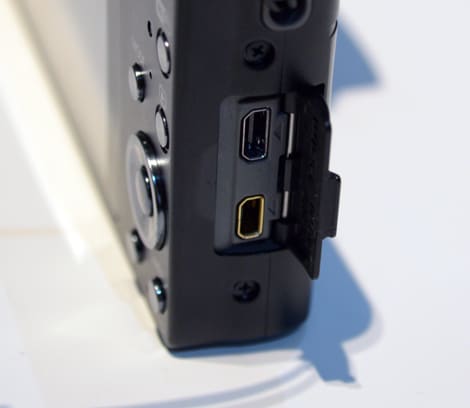
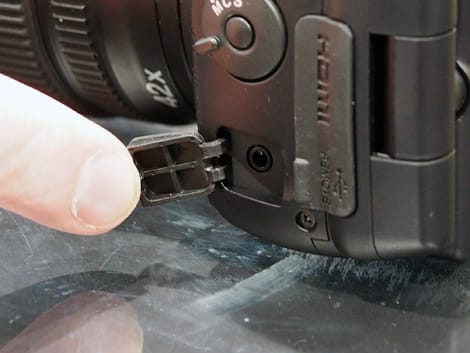
Battery
{{section_header}}{{section.name}}{{/section_header}}
The battery is a rechargeable Lithium-ion make by GE. There is an AC adapter that comes with the {{product.model}} so you can charge it anywhere there is an outlet. Unfortunately, a fully charged battery only yields about 150 shots in Auto mode. Though we would deem this camera a travel-zoom, your travels can't go too far from a home base.

Memory
{{section_header}}{{section.name}}{{/section_header}}
The {{product.model}} takes SD, SDHC, and SDHX cards up to 128GB. There is a minimal internal memory on this model: 15MB.

Conclusion
GE is relatively new to camera production, hoping to take their foot from the door and plant it solidly inside the realm of competitive camera brands. Their high-end point-and-shoot, the {{product.model}} has the features and a price that will certainly make it competitive with the rest of the crowd.
We like the 14.4 megapixel CMOS photo capture and the 10x zoom, on a camera with .7-inches of thickness. There is a solid stabilization mode and a quick shutter that allows for continuous photos and HD video capture. If the photo quality does well in our testing, we think this camera will make a great travel-zoom, something you may want to take with you just about everywhere.
Some of the drawbacks we could see at CES were a slow menu system and it was difficult to distinguish between autofocus and actually taking a picture.
We are a little cautious to say that this camera is spectacular. The list of features is great and places it among some of the best in class, but the price is almost too good to be true. We have to get it in our labs and give it a round of our standard testing to really see if $159.99 MSRP is worth it.
{{product.vanity}}
Sample Photos
{{section_header}}{{section.name}}{{/section_header}}
Specs
{{manufacturer_specs_table}}
Meet the tester
Christian Sherden is a valued contributor to the Reviewed.com family of sites.
Checking our work.
Our team is here to help you buy the best stuff and love what you own. Our writers, editors, and experts obsess over the products we cover to make sure you're confident and satisfied. Have a different opinion about something we recommend? Email us and we'll compare notes.
Shoot us an email